My students know my weaknesses too well. I had a well crafted argument today that I should let them watch Judson Laipply‘s YouTube video, “Evolution of Dance“. The gist of the argument was that they never really understood evolution until they saw the video (we covered evolution last year); the way the dance moves evolved, with small changes from one to the other is an excellent analogy for the gradual evolution of organisms. The best example was how The Robot changed into Breakdancing. I let them watch it of course, it was a good argument and the video is pretty harmless. And if it actually helped them learn about evolution ….
Tag: science
Saturn’s aurora borealis

I came across this beautiful animation of the auroras on Saturn. The auroras are caused by charged particles (ions) from the sun, the solar wind of protons and electrons, are focused down onto areas near the poles of a planet by the magnetic lines of a planet’s magnetic field. The ions hit the atmosphere colliding with atmospheric gas molecules like nitrogen and oxygen causing them to become excited and spit out electrons (becoming ions themselves). Molecules are not “happy” when they’re missing electrons so they’ll capture one to become “fulfilled” (fill their outer electron shells). It’s when they recapture electrons that they give off the light that we see as the auroras.
On Earth the auroras are green or brownish-red (from the Oxygen) and blue or red (from the Nitrogen). Saturn’s atmosphere is mostly hydrogen and helium so we’re not quite sure what color its auroras are. The auroras in the animation were colored in by NASA since the camera on the Cassini spacecraft is black and white.
The video clip below gives a nice explanation of auroras.
Hiking in Lake Catherine State Park, AK
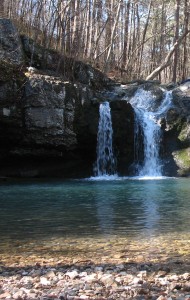
On the last morning of our immersion trip we had a choice between going to Hot Springs, Arkansas, with its geothermal springs and another museum, or hiking at Lake Catherine where we had spent the night. Since we’d been to two museums on the previous day, we pretty unanimously chose the hike. And it was great.

We took the Falls Branch Trail, which follows a couple of young, boulder-choked creeks that have are carving steep-sided valleys through nice clean limestone bedrock. The students were constantly bringing me rocks to identify, and they were almost invariable limestone, with a few pieces of quartz thrown in. The limestone was so clean that it was near translucent (fairly close to marble) and the cobbles in the stream bed were easy to mistake for smoky quartz, particularly if they were rounded enough that you could not look for quartz’s characteristic, curved, conchoidal fracture. Quartz also tends to be a lot harder than limestone, but the ultimate test, which the students really wanted to see, is to put acid on the rock. Limestone fizzes. I did not have any limestone on this trip (note to self: get some HCl for next time), but this little experiment is a nice follow up for our discussions of ionic bonding in chemistry. We have some limestone samples back at school so I plan on doing this as a follow-up.
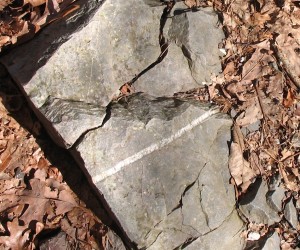
Because Lake Catherine is very close to Hot Springs, it would not be surprising to find some quartz. The hot water that’s coming out of the springs flows up through cracks (faults) that extend deep beneath the surface. The deeper basement rocks are silicates, the granitic rocks that make up the continental crust, so the hot water dissolves some of that silicate material, and when the water cools down, ever so slightly, as it approaches the surface, some of those silicates will precipitate out to coat the walls of the faults with quartz. Sometimes they even fill up the faults entirely, leaving quartz veins.
The stream bed, being of young geological age, was a series of small waterfalls culminating in the five meter high drop that gives the trail its name. The water was clear and cold but with that beautiful aquamarine tint of dissolved limestone. There’s a whole lot more I could say about plunge pools and migrating nickpoints, but I’d probably go on too long. Besides we did not take the time to talk about those since there was so much else to see.
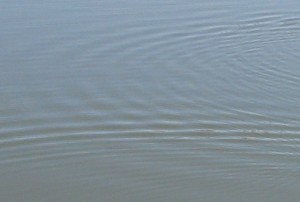
When we reached estuary of Falls Creek and Lake Catherine, the lake’s water was so calm that the kids started trying to skip stones. This of course provided a beautiful opportunity to look at water waves and interference patterns. As the ripples from each skip of the stone expanded, they melded. The constructive interference was easier to see in the field because it made for bigger ripples. But the photos show the destructive interference very nicely.
This was an excellent hike. We were a little pressed for time since we needed to get back to school before the end of the school day, but next time, I think, I’ll have us pack our food in and have lunch on the trail overlooking the waterfall and the lake. The ability to use these types of outdoor experience to integrate the academic work is one of the main reasons I enjoy the Montessori approach to middle school. All through the trip back though I kept thinking about how I could organize things so that we would never need to see the inside of the classroom again.
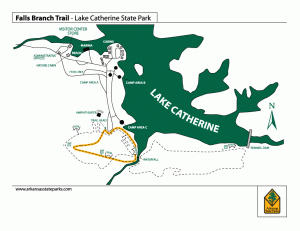
Little Rock Immersion
[googleMap name=”Lake Catherine State Park” description=”Lake Catherine State Park” width=”490″ height=”490″ mapzoom=”12″ directions_to=”false”]1200 Catherine Park Rd, AR 71913-8716[/googleMap]
Just got back from an immersion trip to Arkansas. Every sixth week we get out of the classroom for the week and try to integrate what we’ve learned in the previous five. We’re out there, sometimes visiting somewhere history happened, sometimes hiking in the woods, and I wonder why we don’t spend all of our time outside the classroom. The kids get so much out of just exploring, and there is just so much that sparks the imagination.
Anyway, we hit Central High School, the Clinton Library and stayed and hiked at Lake Catherine State Park (see the map above). We also had a lesson on cameras that tied into our discussion of waves last cycle. I expect to post about each of these, they were all quite good.
Element song (by Tom Leher)
Tom Leher has a number of really entertaining science related songs. Here he does the elements and someone (unknown unfortunately) has made a video to go with it, where the elements all pop up on the periodic table as he sings. Since there is no apparent pattern to order in which he sings the elements, this is more a “strike the imagination” type thing rather than anything else.
Abstract thinking and brain development
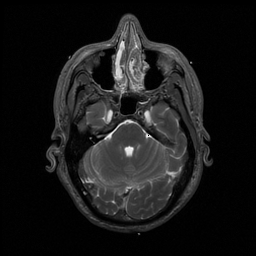
Different parts of the brain mature at different rates. By early adolescence the parts of the brain responsible for social interaction are pretty well developed, but the parts responsible for critical thinking and impulse control (the frontal cortex) are not.
We visited the Le Bonheur Children’s Hospital today. And after a tour, a couple of people from the neurological division gave us a nice little presentation about the human brain. They used Rita Carter’s DVD, “The Human Brain“, which has a great animation of electrical signals pulsing from neuron to neuron through the neural network. I’m considering getting it for the class because the animations and the interactive slicing of the human brain are pretty neat. You can, however, find some, free applications for looking at the whole human body from the Visible Human Project.
Anyway, the fact that impulse control and critical thinking abilities are late to develop did not require fancy brain imaging to discover. Jean Paiget’s research on cognitive developmental stages found evidence that abstract thinking did not develop until the early teens. In fact, he found that abstract thinking (or formal operations as he called it) did not necessarily develop at all. As the frontal cortex matures, the ability to do abstract thinking also develops, but that does not necessarily mean that everyone learns how to do it. (At this point I make an unbiased pitch for the Montessori approach opposed to traditional schooling).
It’s very nice, or perhaps a better word is “elegant”, when very different types of research, using fundamentally different methods come to the same conclusions. In this case, neuroscience (brain imaging), which is ultimately based on physics and biology corroborates the psychological research into cognitive development, which is primarily based on observation and survey.
War games and aggression
In terms of general use, girls utilized computers to connect with others, and boys used computers to compete with others. – Christie (2005)
There are clear gender differences in the way adolescents use computers and play computer/console games. Boys tend toward the violent, competitive games. This is not just my own experience as the above quote from a large study of middle schoolers in South Carolina shows.
Furthermore, and more worrisome, the violence in the games may spill over into real life. In 2004, Gentile et al. found that:
Adolescents who expose themselves to greater amounts of video game violence were more hostile, reported getting into arguments with teachers more frequently, were more likely to be involved in physical fights, and performed more poorly in school. –
They reference a 2001 study by Anderson and Bushman that integrated a lot of the previous work and showed that:
… across 54 independent tests of the relation between video game violence and aggression, involving 4262 participants, there appear to be five consistent results of playing games with violent content. Playing violent games increases aggressive behaviors, increases aggressive cognitions, increases aggressive emotions, increases physiological arousal, and decreases prosocial behaviors. These effects are robust; they have been found in children and adults, in males and females, and in experimental and non- experimental studies
In graphical form it looks like this:

I can’t say I’ve observed this myself, but it is certainly cause for concern. In fact, a later study by the same authors and Nicholas Carnagey (Carnagey et al., 2007) found that people who played violent video games were actually physically desensitized to violence (though the method used in this study is not nearly as convincing as the previous work).
Finally, the degree you can personalize characters in video games is improving rapidly. Some very recent research from Fischer et al. (2010) found that:
playing a violent video game with a personalized game character … increased aggressive responses.
I have to say that I find the evidence from this albeit quick survey of the science to be both disturbing and damning. Of course these scientific studies are statistical averages, and each individual is different and is affected by a larger environment than is just in the violent video games. Indeed, I have played these games myself, I know intensive gamers, and have students who regularly play these games and can’t say that I’ve observed much correlation with the games and aggressive behavior. But then again it is sometimes hard to see the forest from beneath the trees.
I guess I’m going to have to be more strict about violent video games. We don’t allow them in the classroom (in general), but I think I’m going to have to stress the issue a bit more when I talk to students and their parents. Of particular concern is when violent games overlap with video game addiction. As with everything in life, moderation is important, and in a time when students are going through large changes and discovering themselves it is essential to help them with self-regulation.
Waves and earthquakes
There are a lot of Earth Science applications that deal with waves. Seismic waves from earthquakes are a major one that is particularly pertinent after the recent Haitian earthquake. There are quite a number of lesson plans dealing with seismic waves at Larry Braile’s website. Most of the lessons are as practical demonstrations pdf’s and some use downloadable software (Windows only unfortunately), but there are some online applications as well.
In terms of online resources, the IRIS network, produces nice maps of recent earthquake locations. It also has a good page with “Teachable Moments” regarding recent earthquakes. These include the above video of why the Haitian earthquake did not produce a tsunami.
Although it’s not directly related to waves, I particularly like the thermal convection experiment on Braile’s website. It provides, with a baking dish, a sterno can, some water and some thyme, a great example of the convection in the Earth’s mantle that drive plate tectonics.